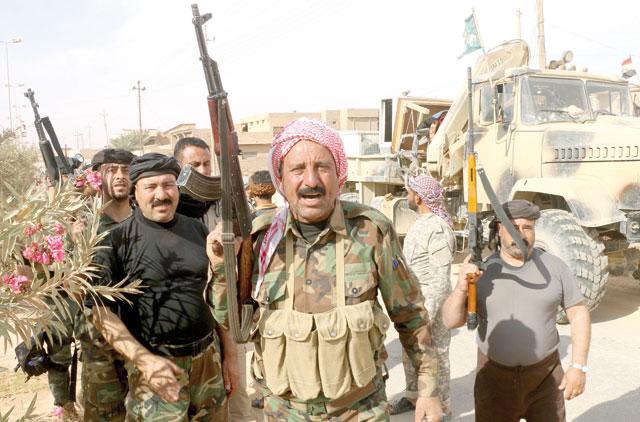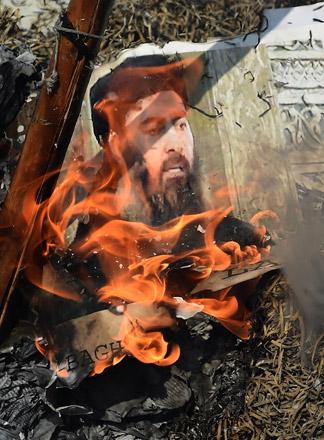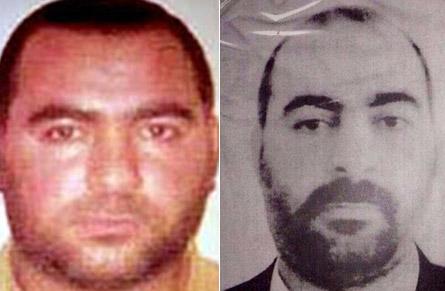You are here
Daesh not dead yet but ‘caliphate’ dream in tatters
By AFP - Nov 18,2017 - Last updated at Nov 18,2017

Iraqi pro-government forces gather in Rawa on Saturday after troops retook the Euphrates valley town from Daesh terror group (AFP photo)
BAGHDAD — Its “caliphate” has imploded, its de facto capitals in Iraq and Syria have fallen, and hundreds of its fighters have either surrendered or fled.
The Daesh extremist group may not be dead yet but its dream of statehood has already been buried, analysts say.
No one in Daesh “will now think of imposing ‘the territory of the caliphate’,” said Hisham Al Hashemi, an Iraqi specialist on extremist movements.
In 2014, self-proclaimed Daesh “caliph” Abu Bakr Al Baghdadi ruled over seven million people in a territory as large as Italy encompassing large parts of Syria and nearly a third of Iraq.
This new “territory of Islam” — Dar Al Islam in Arabic — attracted thousands of extremists from around the world, many accompanied by their wives and children.
The city of Raqqa became the de facto Syrian capital, while Baghdadi made his only public appearance in a mosque in Mosul, Iraq’s second largest city and once a major Middle East trading hub.
In all of the cities the extremist group controlled, the black banner of Daesh flew above the buildings of a new administration.
Courts, hospitals and other official bodies even issued birth or marriage certificates or verdicts and other decrees on Daesh letterhead.
But less than four years after its sweeping offensive stunned the world, Daesh has lost almost all of the territory it controlled along with the precious income from oilfields that funded its activities.
“In the course of recent battles, especially Mosul, a huge number of extremists have died”, said Kirk Sowell, publisher of Inside Iraqi Politics.
“Subsequent to that defeat, many others have surrendered or simply fled the country or are trying to melt into the population.”
According to the US-led coalition fighting Daesh, the extremists have lost 95 per cent of the cross-border caliphate they declared in 2014.
Ever-tightening noose
Hashemi said that after suffering such heavy losses, “even what might remain of Daesh would not think of returning” to the idea of military and administrative control of territory.
And the routed group has been confined in Iraq to “four per cent of the territory: wadis, oases and desert areas” without any population, along the porous border with Syria where it has also been cornered into an ever-tightening noose.
In addition to the Syrian and Iraqi armies, the remaining extremists face myriad forces backed by Russia, the United States or Iran, often at odds with each other over their differing regional interests.
“The caliphate project ran up against geopolitical realities,” according to Karim Bitar of the Paris-based Institute of International and Strategic Affairs.
As a result, “the international extremist galaxy is likely to revert to its previous strategy of de-territorialisation and revert to strikes against the ‘distant enemy’ in the West or Russia to show it must still be reckoned with,” he added.
There is already a figurehead waiting in the wings.
Daesh was born of the ashes of Daesh in Iraq and the Levant and Al Qaeda before it, and Hashemi said that despite the “caliphate” going down in flames, a new organisation is beginning to emerge.
“Most veterans of Daesh and Al Qaeda in Iraq are now regrouping in Syria” where extremist groups still occupy many areas, he said.
These fighters — “the most indoctrinated and most disciplined” — have since September been forming the “Ansar Al Furqan group, led by Hamza Bin Laden”, the son and would-be heir of Osama Bin Laden.
The younger Bin Laden has become active as an Al Qaeda propagandist since his father’s death at the hands of US special forces in 2011 in Pakistan.
In January, the United States added Hamza Bin Laden to its terrorist blacklist.
His father may be dead, but the Bin Laden name continues to attract recruits, Hashemi said.
Related Articles
WASHINGTON — Osama Bin Laden's son Hamza, chosen heir to the leadership of Al Qaeda, has been killed, US media reported on Wednesday citing
BAGHDAD/ERBIL, Iraq — The Daesh terror group leader Abu Bakr Al Baghdadi is on the brink of losing the two main centres of his “caliph
CAIRO/BEIRUT — The Syrian Observatory for Human Rights told Reuters on Tuesday that it had “confirmed information” that the Daesh terror gro
















